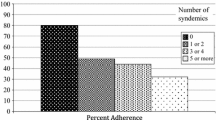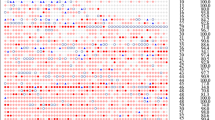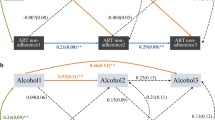Abstract
This study examined longitudinally the additive effect of syndemics, or co-occurring psychosocial problems, on antiretroviral treatment (ART) non-adherence among 390 HIV-positive sexual minority men. Participants completed measures of ART adherence (reduced to a non-adherence score using exploratory factor analysis) and six syndemic conditions. We employed multilevel modeling with the number of syndemics as a longitudinal predictor of non-adherence, and logistic regression with baseline syndemics predicting follow up viral load. Number of syndemics was a significant longitudinal predictor of non-adherence, with each additional syndemic associated with a 0.13 increase in non-adherence (p = 0.004). Each additional syndemic was also associated with 1.27 greater odds of detectable viral load (p = 0.002). Among HIV-positive sexual minority men in this sample, more syndemics were associated with lower ART adherence and greater odds of detectable viral load, suggesting the need for behavioral intervention to facilitate care for this population.
Resumen
Este estudio examinó longitudinalmente el efecto aditivo de sindémicas, o problemas psicosociales concurrentes, sobre la falta de adherencia al tratamiento antirretroviral (ART por sus siglas en inglés) entre 390 hombres VIH positivos de minorías sexuales. Los participantes completaron medidas de adherencia al ART (reducidas a un puntaje de falta de adherencia usando un análisis factorial exploratorio) y seis condiciones sindémicas. Empleamos el modelado multinivel con el número de sindémicas como un predictor longitudinal de la falta de adherencia, y una regresión logística que predice la carga viral de las visitas de seguimiento usando la cita inicial como referencia. El número de sindémicas fue un predictor longitudinal significativo de la falta de adherencia, con cada sindémica adicional asociada con un aumento de 0.13 en la falta de adherencia (p = 0.004). Cada sindémica adicional también se asoció con 1.27 mayores probabilidades de carga viral detectable (p = 0.002). Entre los hombres VIH-positivos de minorías sexuales en esta muestra, más sindémicas se asociaron con menos adherencia al ART y mayores probabilidades de carga viral detectable, sugiriendo la necesidad de una intervención conductual para facilitar el cuidado de la salud de esta población.

Similar content being viewed by others
Notes
A sensitivity test using the log transformed non-adherence factor scores as the outcome variable revealed the same pattern of results as the original model. Syndemics remained a significant predictor of the log transformed non-adherence scores, γ = 0.03, SE = 0.01, t(513) = 0.002. Because the pattern of the results was unchanged, we retained the original factor score distribution with robust standard errors to increase interpretability of the findings.
.
References
Gardner EM, McLees MP, Steiner JF, Del Rio C, Burman WJ. The spectrum of engagement in HIV care and its relevance to test-and-treat strategies for prevention of HIV infection. Clin Infect Dis. 2011;52:793–800.
Cohen MS, Chen YQ, McCauley M, et al. Prevention of HIV-1 infection with early antiretroviral therapy. N Engl J Med. 2011;365:493–505.
Rodger AJ, Cambiano V, Bruun T, et al. Sexual activity without condoms and risk of HIV transmission in serodifferent couples when the HIV-positive partner is using suppressive antiretroviral therapy. JAMA. 2016;316:171–81.
Das M, Chu PL, Santos G-M, et al. Decreases in community viral load are accompanied by reductions in new HIV infections in San Francisco. PLoS ONE. 2010;5:e11068.
Lazo M, Gange SJ, Wilson TE, et al. Patterns and predictors of changes in adherence to highly active antiretroviral therapy: longitudinal study of men and women. Clin Infect Dis. 2007;45:1377–85.
CDC. HIV Surveillance Report, 2015 [Internet]. Centers for Disease Control and Prevention; 2016 Nov. Report No.: 27. Available from: http://www.cdc.gov/hiv/library/reports/hiv-surveillance.html.
Cochran SD, Greer J, Mays VM. Prevalence of mental disorders, psychological distress, and mental health services use among lesbian, gay, and bisexual adults in the United States. J Consult Clin Psychol. 2003;71:53–61.
O’Cleirigh C, Magidson JF, Skeer MR, Mayer KH, Safren SA. Prevalence of psychiatric and substance abuse symptomatology among HIV-infected gay and bisexual men in HIV primary care. Psychosomatics. 2015;56:470–8.
Singer MC, Erickson PI, Badiane L, et al. Syndemics, sex and the city: understanding sexually transmitted diseases in social and cultural context. Soc Sci Med. 2006;63:2010–21.
Singer MC, Clair S. Syndemics and public health: reconceptualizing disease in bio-social context. Med Anthropol Q. 2003;17:423–41.
Ferlatte O, Hottes TS, Trussler T, Marchand R. Evidence of a syndemic among young Canadian gay and bisexual men: uncovering the associations between anti-gay experiences, psychosocial issues, and HIV risk. AIDS Behav. 2014;18:1256–63.
Mimiaga MJ, Biello KB, Robertson AM, et al. High prevalence of multiple syndemic conditions associated with sexual risk behavior and HIV infection among a large sample of Spanish- and Portuguese-speaking men who have sex with men in Latin America. Arch Sex Behav. 2015;44:1869–78.
Parsons JT, Grov C, Golub SA. Sexual compulsivity, co-occurring psychosocial health problems, and HIV risk among gay and bisexual men: further evidence of a syndemic. Am J Public Health. 2012;102:156–62.
Stall R, Mills TC, Williamson J, et al. Association of co-occurring psychosocial health problems and increased vulnerability to HIV/AIDS among urban men who have sex with men. Am J Public Health. 2003;93:939–42.
Guadamuz TE, McCarthy K, Wimonsate W, et al. Psychosocial health conditions and HIV prevalence and incidence in a cohort of men who have sex with men in Bangkok, Thailand: evidence of a syndemic effect. AIDS Behav. 2014;18:2089–96.
Mimiaga MJ, OʼCleirigh C, Biello KB, et al. The effect of psychosocial syndemic production on 4-year HIV incidence and risk behavior in a large cohort of sexually active men who have sex with men. J Acquir Immune Defic Syndr. 2015;68:329–36.
Mustanski B, Phillips G, Ryan DT, Swann G, Kuhns L, Garofalo R. Prospective effects of a syndemic on HIV and STI incidence and risk behaviors in a cohort of young men who have sex with men. AIDS Behav. 2017;21:845–57.
Blashill AJ, Bedoya CA, Mayer KH, et al. Psychosocial syndemics are additively associated with worse ART adherence in HIV-infected individuals. AIDS Behav. 2015;19:981–6.
Kuhns LM, Hotton AL, Garofalo R, et al. An index of multiple psychosocial, syndemic conditions is associated with antiretroviral medication adherence among HIV-positive youth. AIDS Patient Care STDs. 2016;30:185–92.
Biello KB, Oldenburg CE, Safren SA, et al. Multiple syndemic psychosocial factors are associated with reduced engagement in HIV care among a multinational, online sample of HIV-infected MSM in Latin America. AIDS Care. 2016;28:84–91.
Friedman MR, Stall R, Silvestre AJ, et al. Effects of syndemics on HIV viral load and medication adherence in the multicentre AIDS cohort study. AIDS. 2015;29:1087–96.
Safren SA, O’Cleirigh CM, Skeer M, Elsesser SA, Mayer KH. Project enhance: a randomized controlled trial of an individualized HIV prevention intervention for HIV-infected men who have sex with men conducted in a primary care setting. Health Psychol. 2013;32:171–9.
Safren SA, O’Cleirigh C, Skeer MR, et al. Demonstration and evaluation of a peer-delivered, individually-tailored, HIV prevention intervention for HIV-infected MSM in their primary care setting. AIDS Behav. 2011;15:949–58.
Knauz RO, Safren SA, O’Cleirigh C, et al. Developing an HIV-prevention intervention for HIV-infected men who have sex with men in HIV care: project Enhance. AIDS Behav. 2007;11:S117–26.
Reynolds NR, Sun J, Nagaraja HN, Gifford AL, Wu AW, Chesney MA. Optimizing measurement of self-reported adherence with the ACTG Adherence Questionnaire: a cross-protocol analysis. J Acquir Immune Defic Syndr. 2007;46:402–9.
Safren SA, Biello KB, Smeaton L, et al. Psychosocial predictors of non-adherence and treatment failure in a large scale multi-national trial of antiretroviral therapy for HIV: data from the ACTG A5175/PEARLS trial. PLoS ONE. 2014;9:e104178.
Chesney MA, Ickovics JR, Chambers DB, et al. Self-reported adherence to antiretroviral medications among participants in HIV clinical trials: the AACTG Adherence Instruments. AIDS Care. 2000;12:255–66.
Finkelhor D, Hamby SL, Ormrod R, Turner H. The Juvenile Victimization Questionnaire: reliability, validity, and national norms. Child Abuse Negl. 2005;29:383–412.
Meltzer-Brody S, Churchill E, Davidson JR. Derivation of the SPAN, a brief diagnostic screening test for post-traumatic stress disorder. Psychiatry Res. 1999;88:63–70.
Seeley-Wait E, Abbott MJ, Rapee RM. Psychometric properties of the mini-social phobia inventory. Prim Care Companion J Clin Psychiatry. 2009;11:231–6.
Spitzer RL, Kroenke K, Williams JB. Validation and utility of a self-report version of PRIME-MD: the PHQ primary care study. Primary Care Evaluation of Mental Disorders. Patient Health Questionnaire. JAMA. 1999;282:1737–44.
Friedman MR, Coulter RWS, Silvestre AJ, Stall R, Teplin L, Shoptaw S, Surkan PJ, Plankey MW. Someone to count on: social support as an effect modifier of viral load suppression in a prospective cohort study. AIDS Care. 2017;29:469–80.
McDonald LR, Antoine DG, Liao C, Lee A, Wahab M, Coleman JS. Syndemic of lifetime mental illness, substance use disorders, and trauma and their association with adverse perinatal outcomes. J Interpers Violence. 2017;1-20.
Safren SA, Mayer KH, Ou S, et al. Adherence to early antiretroviral therapy: results from HPTN 052, a phase III, multinational randomized trial of ART to prevent HIV-1 sexual transmission in serodiscordant couples. J Acquir Immune Defic Syndr. 2015;69:234–40.
Bauer DJ, Hussong AM. Psychometric approaches for developing commensurate measures across independent studies: traditional and new models. Psychol Methods. 2009;14:101–25.
Jackson DL. Reporting results of latent growth modeling and multilevel modeling analyses: some recommendations for rehabilitation psychology. Rehabil. Psychol. 2010;55:272–85.
Maas CJM, Hox JJ. The influence of violations of assumptions on multilevel parameter estimates and their standard errors. Comput Stat Data Anal. 2004;46:427–40.
Hoffman L, Stawski RS. Persons as contexts: evaluating between-person and within-person effects in longitudinal analysis. Res Hum Dev. 2009;6:97–120.
Simoni JM, Amico KR, Pearson CR, Malow R. Strategies for promoting adherence to antiretroviral therapy: a review of the literature. Curr Infect Dis Rep. 2008;10:515–21.
Safren SA, O’Cleirigh C, Tan JY, et al. A randomized controlled trial of cognitive behavioral therapy for adherence and depression (CBT-AD) in HIV-infected individuals. Health Psychol. 2009;28:1–10.
Safren SA, O’Cleirigh CM, Bullis JR, Otto MW, Stein MD, Pollack MH. Cognitive behavioral therapy for adherence and depression (CBT-AD) in HIV-infected injection drug users: a randomized controlled trial. J Consult Clin Psychol. 2012;80:404–15.
Safren SA, Bedoya CA, O’Cleirigh C, et al. Cognitive behavioural therapy for adherence and depression in patients with HIV: a three-arm randomised controlled trial. Lancet HIV. 2016;3:e529–38.
Starks TJ, Millar BM, Eggleston JJ, Parsons JT. Syndemic factors associated with HIV risk for gay and bisexual men: comparing latent class and latent factor modeling. AIDS Behav. 2014;18:2075–9.
Pantalone DW, Valentine SE, Woodward EN, O’Cleirigh C. Syndemic indicators predict poor medication adherence and increased healthcare utilization for urban HIV-positive men who have sex with men. J Gay Lesbian Ment Health. 2018;22:71–87.
Tsai AC, Burns BFO. Syndemics of psychosocial problems and HIV risk: a systematic review of empirical tests of the disease interaction concept. Soc Sci Med. 2015;139:26–35.
Tsai AC, Mendenhall E, Trostle JA, Kawachi I. Co-occurring epidemics, syndemics, and population health. Lancet. 2017;389:978–82.
Herrick AL, Lim SH, Wei C, et al. Resilience as an untapped resource in behavioral intervention design for gay men. AIDS Behav. 2011;15:25–9.
Herrick AL, Lim SH, Plankey MW, Chmiel JS, Guadamuz TT, Kao U, Shoptaw S, Carrico A, Ostrow D, Stall R. Adversity and syndemic production among men participating in the multicenter AIDS cohort study: a life-course approach. Res Pract. 2013;103:79–85.
Wawrzyniak AJ, Rodríguez AE, Falcon AE, et al. The association of individual and systemic barriers to optimal medical care in people living with HIV/AIDS (PLWHA) in Miami-Dade County. J Acquir Immune Defic Syndr. 2015;69:S63–72.
Funding
This study was funded in by HRSA (H97HA01293) and NIMH (5R01MH068746) awarded to Drs. Kenneth H. Mayer and Steven A. Safren. Some of the author time was supported by NIDA (9K24DA040489) awarded to Dr. Steven A. Safren.
Author information
Authors and Affiliations
Corresponding author
Ethics declarations
Conflict of interest
All authors declare that they have no conflicts of interest.
Ethical approval
All procedures performed in studies involving human participants were in accordance with the ethical standards of the institutional and/or national research committee and with the 1964 Helsinki declaration and its later amendments or comparable ethical standards.
Informed consent
Informed consent was obtained from all individual participants included in the study.
Electronic supplementary material
Below is the link to the electronic supplementary material.
Rights and permissions
About this article
Cite this article
Harkness, A., Bainter, S.A., O’Cleirigh, C. et al. Longitudinal Effects of Syndemics on ART Non-adherence Among Sexual Minority Men. AIDS Behav 22, 2564–2574 (2018). https://doi.org/10.1007/s10461-018-2180-8
Published:
Issue Date:
DOI: https://doi.org/10.1007/s10461-018-2180-8




